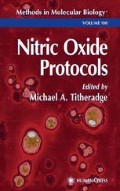Abstract
Nitric oxide (NO) produced from L-arginine during the activation of nitric oxide synthase(s) (NOS) in cells has pleiotropic effects and can behave as an intracellular modulator of cellular activity, as well as an intercellular messenger which diffuses from the originator cell to affect other “target” cells in a paracrine manner. NO effects on cells include adenine diphosphate (ADP)-ribosylation and nitrosation/nitration of proteins, and the activation of soluble guanylyl cyclase (GC-S) to form guanosine 3′,5′-cyclic monophosphate (cGMP) (1). GC-S contains heme as a prosthetic group, and NO apparently binds to the heme moiety and induces a conformational change in the enzyme which either dis-inhibits or activates the catalytic site (2). NO activation of GC-S has been demonstrated for numerous tissues. NO’s ability to activate GC-S and increase cGMP levels has been used to advantage to determine the production and levels of NO in originator cells as well as in target cells employed in the capacity of a bioassay. Whereas the half-life of NO is very short and the gas is difficult to measure during short periods of stimulation, in the presence of a phosphodiesterase inhibitor, the levels of cGMP produced in response to GC-S activation are stable and quantitative. Variations on the assay methods for NO-stimulated cGMP production include incubating the cytosolic fraction of cells with purified GC-S for quantitation of cGMP (3), prelabeling cells with [3H]guanosine for quantitation of [3H]cGMP (4), and adding cells or the supernatant fractions from cells stimulated for NOS activity to NO target cells, such as RFL-6 cells, which are rich in GC-S and respond in a sensitive manner to exogenously supplied NO, for quantitation of cGMP production (5).
Access this chapter
Tax calculation will be finalised at checkout
Purchases are for personal use only
References
Kerwin, Jr., J. F., Lancaster, J. R., and Feldman, P. L. (1995) Nitric oxide: a new paradigm for second messengers. J. Med. Chem. 38, 4342–4362.
Schmidt, H. H. H. W., Lohmann, S. M., and Walter, U. (1993) The nitric oxide and cGMP signal transduction system: regulation and mechanism of action. Biochim. Biophys. Acta 1178, 153–175.
Mulsch, A. and Busse, R. (1991) Nitric oxide synthase in native and cultured endothelial cells—calcium/calmodulin and tetrahydrobiopterin are cofactors. J. Cardiovasc. Pharmacol. 17, S52–S56.
Pou, S., Pou, W. S., Rosen, G. M., and El-Fakahany, E. E. (1991) N-Hydroxylamine is not an intermediate in the conversion of L-arginine to an activator of soluble guanylate cyclase in neuroblastoma N1E-115 cells. Biochem. J. 273, 547–552.
Ishii, K., Chang, B., Kerwin, Jr., J. F., Huang, Z.-J., and Murad, F. (1990) N-Omega-nitro-L-arginine: a potent inhibitor of endothelium-derived relaxing factor formation. Eur. J. Pharmacol. 176, 219–223.
Steiner, A. L., Kipnis, D. M., Utiger, R., and Parker, C. (1969) Radioimmunoassay for the measurement of adenosine 3′,5′-cyclic phosphate. Proc. Natl. Acad. Sci. USA 64, 367–373.
Domino, S. E., Tubb, D. J., and Garbers, D. L. (1991) Assay of guanylyl cyclase catalytic activity. Methods Enzymol. 195, 345–355.
Author information
Authors and Affiliations
Editor information
Editors and Affiliations
Rights and permissions
Copyright information
© 1998 Humana Press Inc.
About this protocol
Cite this protocol
Laychock, S.G. (1998). Determination of NOS Activity Using Cyclic-GMP Formation. In: Titheradge, M.A. (eds) Nitric Oxide Protocols. Methods in Molecular Biology™, vol 100. Humana Press. https://doi.org/10.1385/1-59259-749-1:93
Download citation
DOI: https://doi.org/10.1385/1-59259-749-1:93
Publisher Name: Humana Press
Print ISBN: 978-0-89603-470-9
Online ISBN: 978-1-59259-749-9
eBook Packages: Springer Protocols

